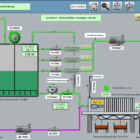A positioner is a device that is used in combination with a control valve to adapt the exact position of the valve to the requirements of a control signal. The positioner ensures that the valve reaches the desired position precisely and reliably, regardless of external influences such as pressure fluctuations, friction or vibrations.
In industrial water and wastewater technology, the positioner is an indispensable instrument for the efficient and stable control of processes such as dosing, pressure control, flow control and chemical precipitation.
Table of contents
Structure of a positioner
A positioner typically consists of the following components:
Input signal receiver:
- Accepts control signals (e.g. 4-20 mA, 0-10 V or pneumatic signals) from a process control system or a control unit.
Measuring system:
- Measures the actual position of the valve using potentiometers, sensors or position measuring systems.
Comparison unit:
- Compares the input signal with the current valve position and determines the required correction.
Final control element (actuator):
- Influences the pneumatic or electric control of the valve to achieve the desired position.
Feedback system:
- Transmits the current valve position back to the control unit to ensure precise control and monitoring.
Housing:
- Made of robust materials such as stainless steel or aluminum to protect the positioner from environmental influences such as moisture, dust or chemicals.
Functionality of a positioner
The operation of a positioner can be divided into several steps:
Signal reception:
- A control system sends a setpoint signal (e.g. 12 mA for a 4-20 mA signal) that represents the desired valve position (e.g. 50 %).
Position detection:
- The positioner measures the current valve position via a position sensor or a potentiometer.
Variance analysis:
- The controller compares the setpoint with the actual valve position and calculates a deviation.
Correction:
- In the event of a deviation, the positioner activates the actuator (e.g. a pneumatic or electric actuator) to adjust the valve position accordingly.
Feedback:
- Once the desired position has been reached, the positioner provides feedback to the control system, creating a closed control loop.
Types of positioners
Pneumatic positioners:
- Operate with compressed air and are particularly common in potentially explosive atmospheres (ATEX zones).
- Advantages:
- Robust construction.
- Insensitive to electrical interference.
- Typical use:
- Control of control valves in chemical or petrochemical plants.
Electronic positioners:
- Work with electrical signals (e.g. 4-20 mA) and are compatible with digital control systems.
- Advantages:
- Precise regulation.
- Integration into process control systems (e.g. via HART, Profibus or Modbus).
- Typical use:
- In highly automated water and wastewater systems.
Electro-pneumatic positioners:
- Combine electrical signal inputs with pneumatic control.
- Advantages:
- High precision and compatibility with pneumatic valves.
- Typical use:
- Applications with pneumatic control valves and digital control.
Applications in water and wastewater technology
1. flow control
- Use:
- In piping systems for precise control of water or chemical flows.
- Example:
- Control of the feed to filtration systems or chemical dosing during flocculation.
2. pressure control
- Use:
- Maintaining a constant pressure in drinking water or process water systems.
- Example:
- Control of pump pressure in closed
3. filtration systems
- Use:
- Control of the backwash cycles for multi-layer filters or membrane systems.
- Example:
- Control of reverse osmosis through precise control of the permeate and concentration flows.
Advantages of using positioners
Precision and reliability:
- Precise adjustment of the valve position even with fluctuating process conditions.
Energy efficiency:
- Avoiding over- or under-regulation saves energy and reduces operating costs.
Flexibility:
- Suitable for use in a wide range of processes and media (water, chemicals, sludge).
Optimization of process control:
- Creation of stable process conditions through closed control loops.
Integration into automation systems:
- Enables remote monitoring and control via modern communication protocols.
Conclusion
The positioner is an important tool for the precise control of processes in water and wastewater technology. Thanks to its ability to position control valves precisely, it makes a decisive contribution to the efficiency, stability and automation of systems. Thanks to their digital interfaces, high reliability and robust design, modern positioners offer a future-proof solution for demanding applications. Their integration into industrial processes enables optimum process control and helps to comply with environmental regulations and reduce operating costs.
For further information on our products, please feel free to contact us at any time!







